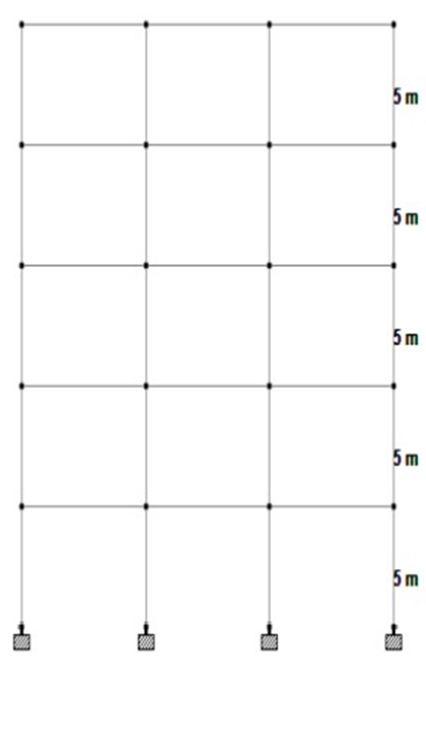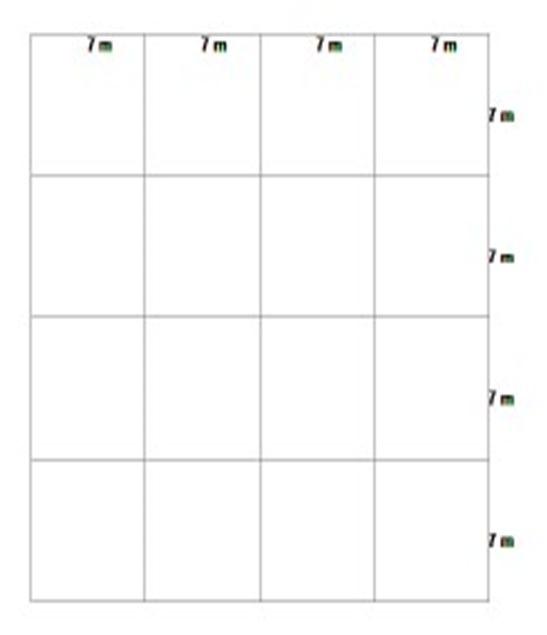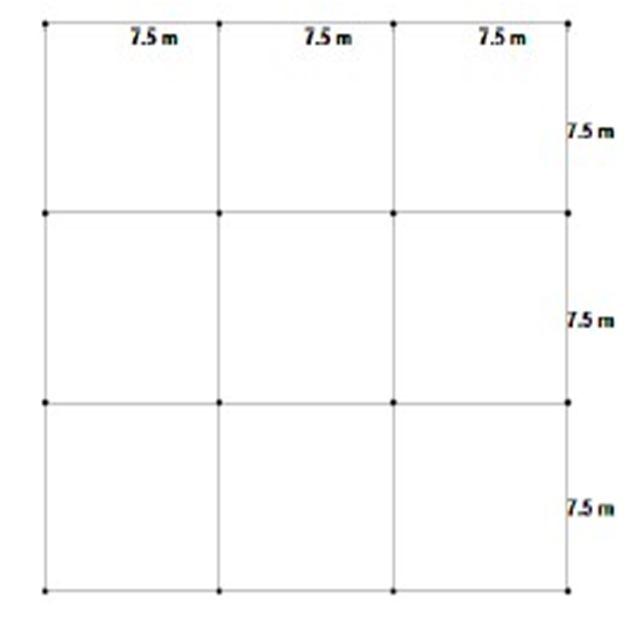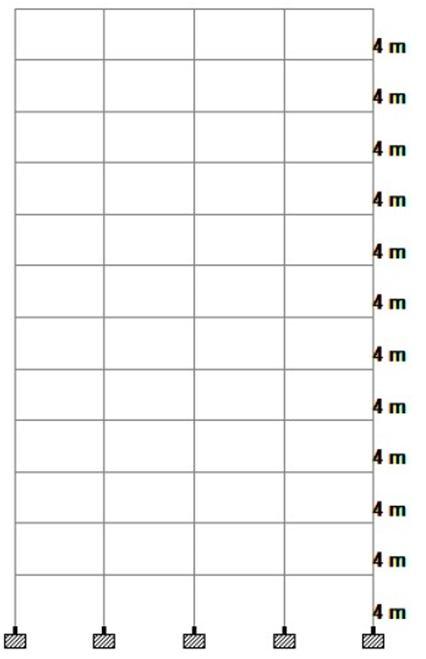
ISSN: 2321-9653; IC Value: 45.98; SJ Impact Factor: 7.538

Volume 11 Issue I Jan 2023- Available at www.ijraset.com


ISSN: 2321-9653; IC Value: 45.98; SJ Impact Factor: 7.538

Volume 11 Issue I Jan 2023- Available at www.ijraset.com
Refaat Taleb Ismail1, K.Rama Mohana Rao2 , Srikanth Devi3
1Department of Civil Engineering, JNTU Hyderabad, India
2Civil Engineering Department and Director BICS, JNTU Hyderabad, India
3Department of Civil Engineering, Malla Reddy Engineering College (Autonomous), Hyderabad, India
Abstract: In the context of the seismic evaluation of building structures, nonlinear static analysis that makes use of pushover processes is becoming an increasingly common technique in engineering practice. In order to carry out a pushover study, the document FEMA-356 (2000) suggests using a variety of distributions of lateral forces. The use of these force distributions, on the other hand, does not adequately reflect the effects of modifying dynamic parameters across the inelastic response or the influence of higher modes. Four different lateral load patterns are investigated in this body of work by contrasting the pushover responses of RCC moment frame buildings with five and twelve stories.
Keywords: Nonlinear Static analysis, Lateral Load Distributions Pattens, FEMA 356:2000.
Force-based design principles are being used in modern times to determine how structures should be designed to withstand seismic effects. In structural earthquake engineering practice, however, performance-based seismic assessment approaches are employed to examine the inelastic deformation demand of structural parts. A "pushover" study, in which a model of the building structure is subjected to an inverted variation distribution of lateral pressures, is one of the most common and well-liked methods for determining how to assess these demands. This study involves the application of lateral pressures to the model of the building structure.
Fig 1. The generalized force deformation relation while exhibiting nonlinear behavior of a structural member

Figure 1 demonstrates the ductile behavior of a component that is representative of the norm. This behavior is characterized by a variety of elasticity (from point A to point B on the curve). After that, there is a plastic range, which goes from point B to point E, and it includes strain hardening, which goes from point B to point C, and a strength-degraded range, which goes from point C to point D. After that, there is an elastic range, which goes from point A to point E. After that, there is an elastic range, which goes from point A to point E. The amount of residual force that can be resisted is notably less than the peak strength, yet it is still a meaningful quantity within the period in which the strength is deteriorating. The acceptance criteria for essential components, which are generally anticipated to exhibit a ductile behavior, may normally be found anywhere between the elastic or plastic ranges between points B and C. However, these requirements might vary depending on the performance level. These materials may be elastic or they may have a plastic quality.

ISSN: 2321-9653; IC Value: 45.98; SJ Impact Factor: 7.538

Volume 11 Issue I Jan 2023- Available at www.ijraset.com

In this study, the application of static loads takes place in stages up to the point when the structure has reached its ultimate condition. This procedure is repeated until all of the data has been analyzed. The numerous parts and characteristics of the structure have been broken down and examined with the use of a non-linear mathematical model, which is where the non-linearity in the research can be traced back to.
In the following paragraphs, an overarching discussion of the key stages of the analysis will be presented. The process is divided into four distinct steps when the non-linear static technique is used, each of which is described in more detail below and shown in the accompanying figures:
1) Define the mathematical model with the non-linear force deformation relationships for the various components/elements.
2) Define a suitable lateral load pattern.
3) Idealize the force-displacement curve.
4) Evaluate the performance of the building.
It is not possible to separate the force distribution in a simple way because of the changing stiffness and the multiple mode effects that occur over the course of the seismic event. FEMA 356 has recommended a number of different designs, ranging from the easy uniform and inverted triangular patterns to the more complicated ones, such as the modal patterns. The patterns that are recommended by FEMA 356 are referred to in order to accomplish the task of determining how well the structure performs under various conditions.
Uniform FEMA EFM Multi Modal 273 (SRSS) Fig 2. Typical Load Patterns
The common lateral load patterns are shown in Figure 2, which shows how they were taken into consideration for this inquiry. These lateral load profiles provide a representation of the distribution of inertial forces that were exerted over the course of an earthquake. The following is how the lateral load patterns should be classified in order to account for the effects of the inertia forces that were imposed on the structure as a result of the seismic event. This is something that can be understood in a straightforward manner. It is essential to remember that the storey forces are normalized with the base shear in order to achieve a total base shear that is equal to unity. Keeping this fact in mind is very crucial.
During this research, a total of four different lateral load patterns were used in order to get an approximation of the distribution of inertia forces that were placed on the structure as a result of a seismic occurrence. The next description will go over how these lateral load patterns are described. It is essential to remember that the storey forces are normalized with the base shear in order to achieve a total base shear that is equal to unity. Keeping this fact in mind is very crucial.


The lateral force at any storey is proportional to the mass at that storey, i.e., (1)
Where Fi: lateral force at i-th storey mi: mass of i-th storey
ISSN: 2321-9653; IC Value: 45.98; SJ Impact Factor: 7.538

Volume 11 Issue I Jan 2023- Available at www.ijraset.com
The lateral force at any storey is proportional to the product of the amplitude of the elastic first mode and the mass at that storey, i.e. (2)
Where Øi: amplitude of the elastic first mode at i-th storey

The lateral load pattern defined in FEMA-273 is given by the following formula that is used to calculate the lateral force at any storey:




(3)
Where h: height of the i-th storey above the base k: a factor to account for the higher mode effects (k=1 for T1≤0.5 sec and k=2 forT1>2.5 sec and varies linearly in between T1 fundamental time period)
The lateral load pattern considers the effects that are caused by the impacts of higher modes of vibration over a longer period of time and irregular structures. In addition to this, the lateral force at each story is calculated by combining the load distributions that were produced from the modal analysis of the structures in the following manner:
1) Calculate the lateral force at i-th storey for n-th mode from Equation (5)

Where Pn: modal participation factor for the n-th mode
Øin: amplitude of n-th mode at i-th storey An: pseudo-acceleration of the n-th mode SDOF elastic system
2) Calculate the storey shears,
(5)
(6)
Where N is the total number of stories 3. Combine the modal storey shears using SRSS rule.
3) Back calculate the lateral storey forces, Fi, at storey levels from the combined storey shears, Vi starting from the top storey.
4) Normalize the lateral storey forces by base shear for convenience such that .
(7)
In this study, the "multi-modal" or SRSS lateral load pattern was estimated by taking into consideration the contributions of the first three elastic modes of modal analysis. This allowed for a more accurate representation of the lateral load distribution. The "Elastic First Mode," "FEMA-273," and "Multi-Modal (or SRSS)" lateral load patterns, respectively, are used to depict the inverted triangle lateral load patterns. The pattern of "uniform" or uniformly distributed lateral loads is the most severe illustration of an invariant lateral load distribution.
In order to carry out the process of evaluating the many different load distributions, two extraordinary moment-resistant RCC frame constructions were selected to act as representative case studies. An analysis was performed on reinforced concrete frame buildings ranging in height from five to twelve storeys using SAP 2000 version 11, specifically the non-linear static analysis based on FEMA356.
In the case of columns, axial deformation is also taken into account in addition to the flexural and shear deformations that are modeled for the elements of beams and columns for flexural and shear deformations
ISSN: 2321-9653; IC Value: 45.98; SJ Impact Factor: 7.538 Volume 11 Issue I Jan 2023- Available at www.ijraset.com

782
.
Fig 3: Elevation of 5 storey and 12 storey RCC Buildings
Fig 4: Plan of 5 storey and 12 storey RCC buildings





This section presents a summary of the results obtained for the both structures, in particular, Global structure behavior and Storey displacements.

The pushover curves for the whole planet, as anticipated by analytical models, are shown in figures 5 and 6., respectively. Throughout the course of the nonlinear static analysis, a total of four distinct lateral load patterns are used. This has been explained in more detail before. When attempting to represent the global behavior of the models, the roof displacement versus base shear diagrams for each load pattern are plotted on the same graph. The term "pushover curve" will be used to refer to this particular curve.
According to the findings of the study, the amount by which the uniform load pattern deviates from the other lateral load instances increases in proportion to the rise in the number of stories. This finding was reached by analyzing the relationship between the number of stories and the uniform load pattern. In addition to this, it was found that the SRSS load patterns and the FEMA 273 load patterns are consistent with one another. [Citation needed] The UNIFORM and the SRSS are separated by the EFM, which acts as a buffer between the two.

ISSN: 2321-9653; IC Value: 45.98; SJ Impact Factor: 7.538 Volume 11 Issue I Jan 2023- Available at www.ijraset.com

Fig 5:. Push over Curve for 5 Storey R/C building
Fig 6:. Push over Curve for 12 Storey R/C

After the pushover analysis has been completed using the four distinct load patterns, the resulting floor displacements are presented on the same graph for each different degree of deformation. This is done in order to compare the results. Utilizing these curves as a point of comparison and doing research on the results is possible thanks to the availability of this resource. According to the findings of the study, it can be shown that the stacked displacements derived from the pushover analysis for each of the four different load patterns are, in general, rather close to one another for the first two deformation levels. This conclusion was reached as a result of the fact that the study was able to demonstrate that the story displacements are relatively close to one another. When compared to the FEMA and SRSS load patterns for both 5 and 12 stories at 3, 4, and 5 deformation levels, the UNIFORM load pattern displays bigger values as the deformation level increases. This is the case for all deformation levels. In each of the three load patterns, this is the situation. The EFM pattern achieves the best possible outcomes in terms of value.



ISSN: 2321-9653; IC Value: 45.98; SJ Impact Factor: 7.538 Volume 11 Issue I Jan 2023- Available at www.ijraset.com
Fig 7. Storey displacements of 5 storey model for 6 deformation levels






ISSN: 2321-9653; IC Value: 45.98; SJ Impact Factor: 7.538 Volume 11 Issue I Jan 2023- Available at www.ijraset.com

Fig 8. Storey displacements of 12 storey model for 6 deformation levels




The following conclusions have been arrived from the study.
1) Because the height-wise distribution of triangular lateral load patterns in mid-rise frames varies so little, the predictions that the triangular lateral load patterns provide for the global capacity curve and the storey displacement ratio are nearly identical.This is because there is very little variance in the height-wise distribution of triangular lateral load patterns. In light of this, the estimation of seismic needs for a structure of medium height might make use of any triangular lateral load pattern


ISSN: 2321-9653; IC Value: 45.98; SJ Impact Factor: 7.538 Volume 11 Issue I Jan 2023- Available at www.ijraset.com

2) Large discrepancies were found in the seismic demand prediction of triangular lateral load patterns for high-rise buildings. These differences may be attributed to the significant diversity that exists in the height-wise distribution of triangular lateral load patterns for high-rise structures. These variations were found to be of significant magnitude upon closer inspection.
3) The predictions of "Multi-Modal (SRSS)" and FEMA 273 lateral load patterns for storey displacement made by triangle lateral load patterns for both buildings are primarily located in the middle of those made by triangular lateral load patterns. This is due to the fact that triangle lateral load patterns are used for both buildings. As a result, it is recommended that the storey displacement needs of buildings be assessed by averaging the estimates generated by "Multimodal (SRSS)" and "FEMA 273.
4) It is recommended that the "Elastic First Mode," the simplest load pattern there is, be used so that the pushover analysis of buildings may be properly carried out. This advice is supported by the results that are provided here.
5) Considering the conclusions that were discussed in this article, the usage of the "uniform" load pattern is not suggested for all buildings. This is because the "uniform" load pattern does not match a realistic distribution of inertia forces over the height of the structure. This is shown by the fact that the outcomes that were pertinent to the inquiry had a great deal of variance amongst them.
[1] Anil K. Chopra" Estimating Seismic demands for Performance-Based Engineering of Buildings" 13th World Conference on Earthquake Engineering Vancouver, B.C., Canada August 1-6, 2004 Paper No. 5007.
[2] Computers and Structures Inc. (CSI), 1998, SAP2000 Three Dimensional Static and Dynamic Finite Element Analysis and Design of Structures V 11.0.0, Berkeley, California.

[3] E. Kalkan and S. K. Kunnath “Lateral Load Distribution in Nonlinear Static Procedures for Seismic Design “ASCE 2004.
[4] Federal Emergency Management Agency (FEMA), 2000, Pre standard and Commentary for the Rehabilitation of Buildings, FEMA-356.
[5] Houssam Mohammad Agha, Li Yingmin , Oday Asal Salih and A’ssim Al-Jbori "Nonlinear Performance of a Ten-Storey Reinforced Concrete Special Moment Resisting Frame (SMRF) " The 14th World Conference on Earthquake Engineering October 12-17, 2008, Beijing, China .
[6] Indian Standard "Criteria for Earthquake Resistant Design of Structures" IS 1893 (Part-1) -2002
[7] Indian Standard "Code of Practice for Design Loads (Other Than Earthquake) for Buildings and Structures" IS 875 PART 1 Dead Loads Unit Weights of Building Materials And Stored Materials.
[8] Indian Standard "Code of Practice for Design Loads (Other Than Earthquake) for Buildings And Structures "Is 875 Part 2 Imposed Loads.
[9] Mehdi Poursha Faramarz Khoshnoudian and A.S. Moghadam "A Breakthrough in Estimating The Seismic Demands of Tall Buildings " The 14th World Conference on Earthquake Engineering October 12-17, 2008, Beijing, China.
